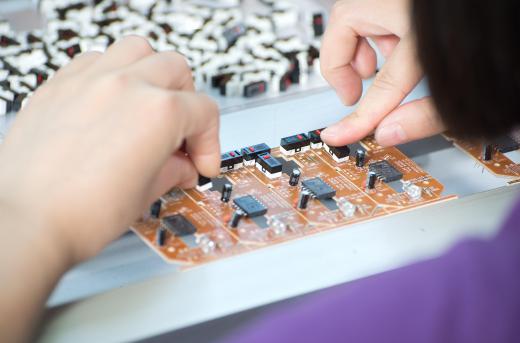A copper pour is a component of printed circuit board (PCB) design. PCBs, which are thin boards covered with electrical pathways, are used in most electronic devices and employ the metal copper as an electrical conductor. Although some copper is etched away during the PCB manufacturing process, other copper is left in place to create a conductive surface. This layer of copper, which appears to “flow” around the individual electronic components of the circuit board, is the copper pour.
Copper metal is widely used in electronics because it has a very high conductivity. The structure of copper at the atomic level consists of a lattice of atoms held together by weak metallic bonds. This allows the copper electrons to easily flow through the lattice from one atom to another, carrying energy in the form of electricity or heat.

PCBs work by using the conductivity of copper to transmit electrical signals from one electronic component on the board to another. In most cases, a PCB is made by laminating a thin foil of copper onto an inert substrate material for support. Excess copper is then etched away using chemicals, preserving only the connections required for operation.
A copper pour can be advantageous to PCB design because it reduces the amount of chemical etching required by leaving a relatively large space of copper on the board. Since it fills in the board around the individual electronic components, the copper pour can also connect those components and conduct electricity. The areas of a PCB intended for copper pour are planned out and modeled in advance during the circuit design process using special software.
Another important function of a copper pour is its use as a ground plane. As a ground plane, the layer of copper actually exists on a different layer, or electrical net, from the other components and is connected to them only as a grounding material. The electricity in the PCBs of an electronic device is grounded, or routed down, into the copper pour, giving the circuit boards a common point of reference from which to determine voltage. It is often important for PCBs to measure signal voltage from this common point, which is known as the reference potential.
In addition to its applications in electrical conductivity, copper also has high thermal conductivity and can be used as a heat sink. Heat sinks are substances that transmit excess heat away from high-temperature components and are used in electronics to prevent devices from overheating. In a PCB, heat energy generated by electrical parts can be routed into the copper pour, allowing the circuit board to function more effectively.
